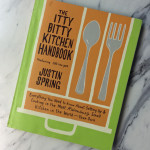Ten months ago, the two of us, Chef Sin and Chef Zuz, decided to move from the third-largest city in the Northwest to a small town in Oregon. Doing so meant moving into a much smaller house. And that came with a much smaller kitchen.
Our previous cooking space was pretty sweet. After a 2006 remodel, it had a nice gas cooktop, a capacious wall oven, and a spring-loaded shelf that meant we didn’t need to lug the monster stand mixer in and out of the cabinet any more. Best of all, this kitchen was large enough for the two of us to cook together — and that’s how Cuisine Stupide was born.
Our new space is barely one-third of the size of the old. It’s what a realtor would spin as an “efficiency kitchen.” Which is to say, more than galley, but a whole lot less than gourmet. And we found its limitations and pinch points almost immediately.
The lack of an automatic dishwasher would have been tolerable, but the corner-mount double sink was barely six inches deep and so close to the edge of the counter that it virtually guaranteed a Niagara of dishwater all over the floor and us. The apartment-style refrigerator/freezer meant little room for staples, much less leftovers. The electric range was both old and cheap: no oven light, and the stovetop coils were so warped, Chef Sin couldn’t even fry an egg properly. And cupboard space was severely limited; our Costco card, and the opportunity to buy in bulk that it offers, suddenly became a lot less practical.
True, most of this was merely annoying. And perspective is important: Even our downsized kitchen is, by many measures, extravagant; a lot of people in this world would be happy to have a hotplate, or just a reliable source of clean water.
Still, we were determined to make better use of what we had.
 I sought guidance from The Itty Bitty Kitchen Handbook by Justin Spring (2006), which came highly recommended by Kevin Kelly’s reliable Cool Tools website. Unfortunately, I found the book more annoying than cool (due to some terrible design and typography choices) and useful only to the extent that it’s extremely thorough in stating the obvious. (Really, an entire page detailing how to clean a toaster?) The book seems pitched mostly toward young people setting up their first kitchens.
I sought guidance from The Itty Bitty Kitchen Handbook by Justin Spring (2006), which came highly recommended by Kevin Kelly’s reliable Cool Tools website. Unfortunately, I found the book more annoying than cool (due to some terrible design and typography choices) and useful only to the extent that it’s extremely thorough in stating the obvious. (Really, an entire page detailing how to clean a toaster?) The book seems pitched mostly toward young people setting up their first kitchens.
For those of us who have been cooking for a while and find ourselves bumping elbows, here are a few things Cuisine Stupide has learned about getting small:
- If the place is yours (that is, you’re not renting), invest in the best appliances that the space will accommodate and you can afford. Our kitchen space is still small, but a new smooth-top electric range, deeper sink, and functional faucet have made cooking seem less like a scene from Das Boot.
- On the other hand, don’t buy or keep more cooking equipment than you really need and your cupboards can accommodate. And don’t be tempted to use your limited counter space for storage; when you’re looking for a place to put that heavy pasta pot, it will just piss you off.
- That said, ensure the highest and best use of every inch you’ve got. An inexpensive wall-mounted utensil rail from IKEA keeps our frequently used kitchen tools handy but out of the way, and takes the place of at least two drawers that we don’t have.
- Get used to the idea that there are some things you’ll never cook in a small kitchen — or you’ll do so once and swear, “Never again.” Frying fish, for example, or anything that resembles indoor grilling; like a rude house guest, the smoke won’t leave for weeks.
- Aesthetics matter. Refinishing our 1970s-vintage cabinets made the kitchen feel more usable, even if it didn’t expand its footprint (and so much less expensive than new cabinetry). Put some liner paper on the shelves, some vases on the window sill, a bowl of fresh fruit on the table. Make it yours.
- Most of all, find the dishes that you’re able to cook and love to eat, and make them. And if the kitchen is too small for two chefs, give one the night off.

You’re awesome; had no idea of your talent